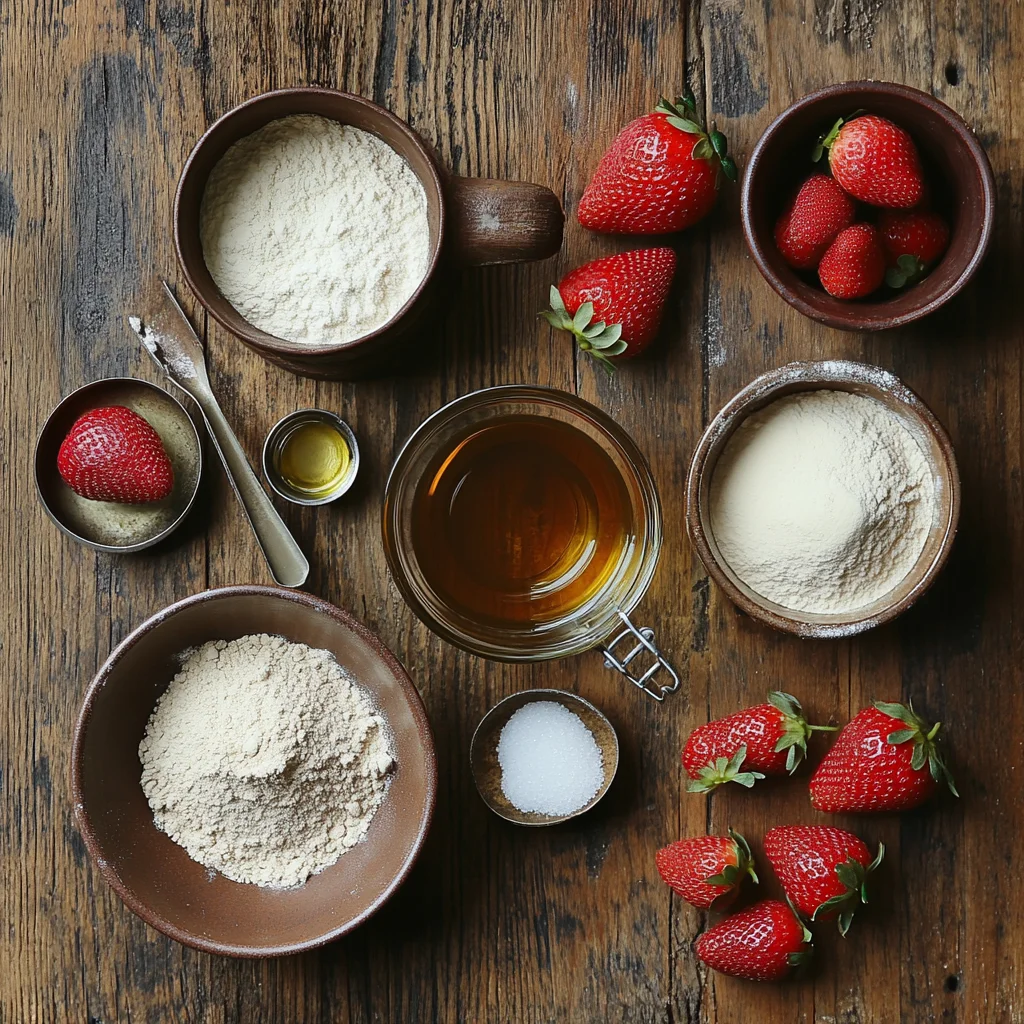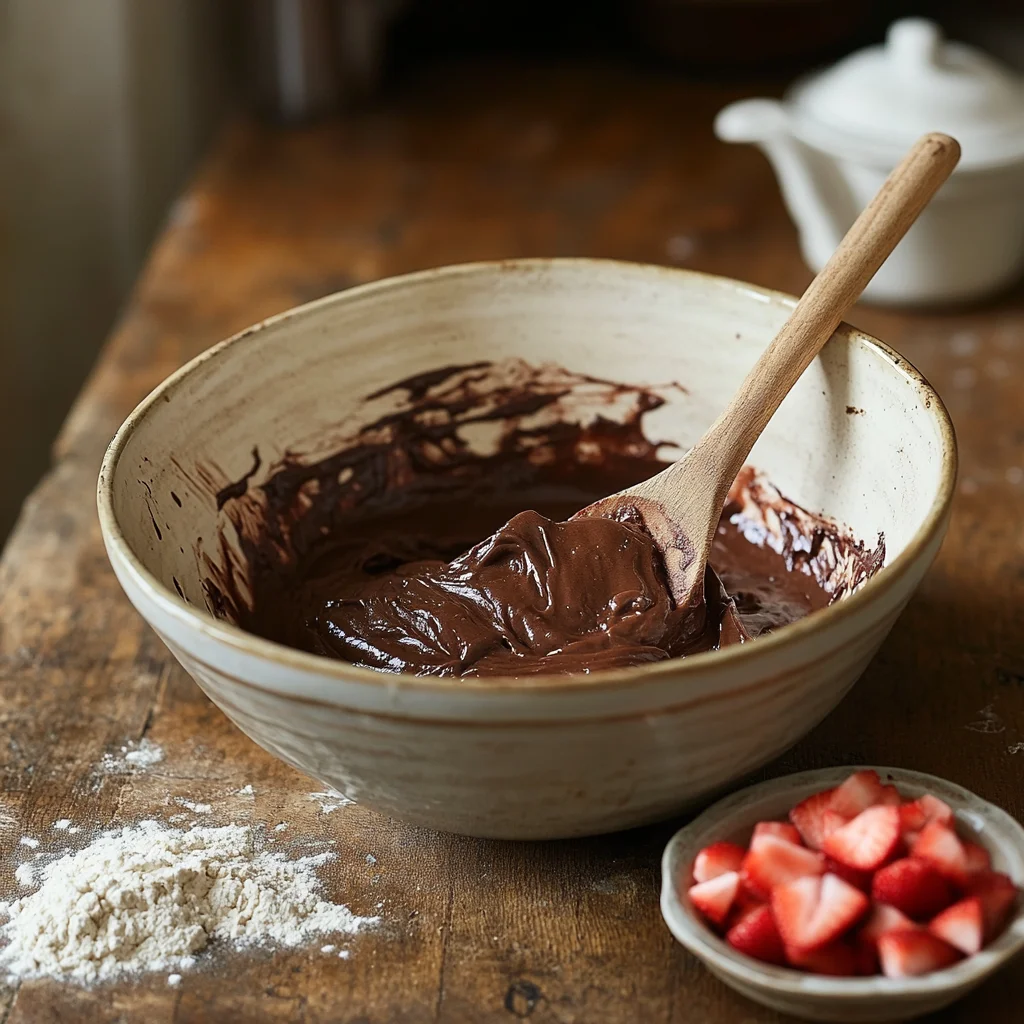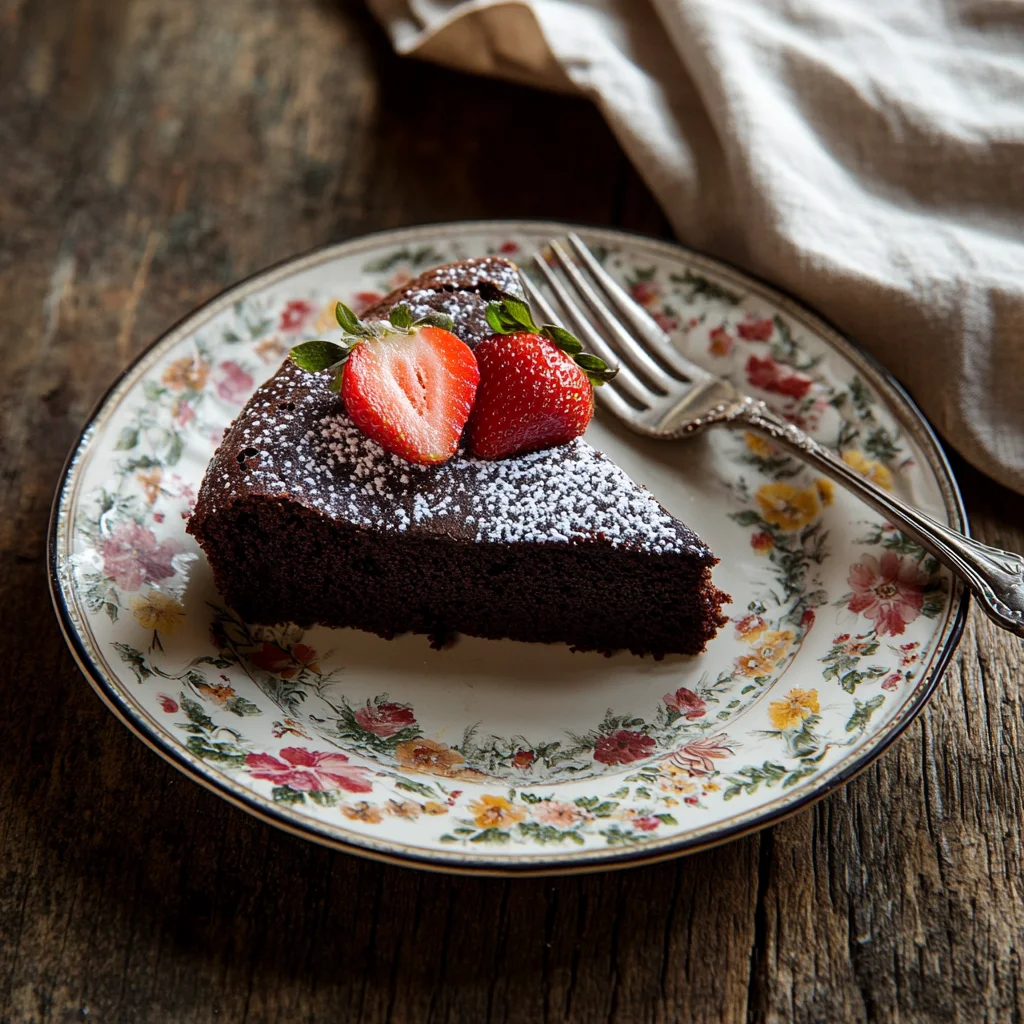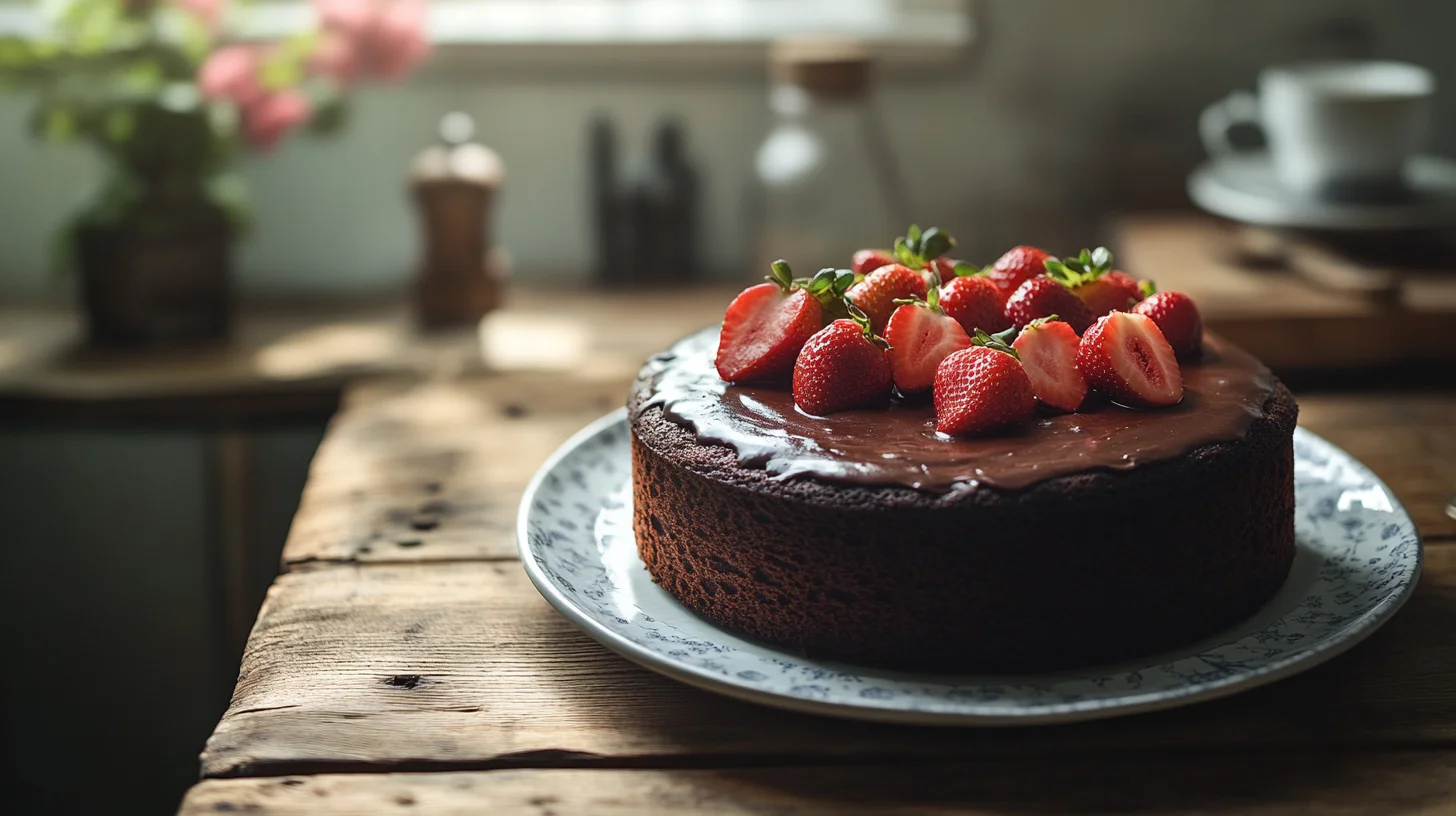Growing up, I remember my Nonna telling stories of the Great Depression—not just of the struggle, but of the strength and creativity it sparked. One of those stories often ended in a simple but rich chocolate cake, made without eggs, milk, or butter. “We called it the Depression cake,” she’d say, “but there was nothing depressing about the way it tasted.”
Depression Cake, also known as “Wacky Cake” or “War Cake,” is more than just a dessert—it’s a piece of culinary resilience. Born out of necessity during the 1930s in the United States, this cake symbolized resourcefulness when certain ingredients were scarce or rationed. In this article, we’ll explore the depression cake origin, its cultural impact, and my personal twist: the addition of fresh strawberries for a touch of fruity brightness.
What is Depression Cake origin?
Depression cake is a simple, moist cake made without common baking essentials like eggs, butter, or milk. During the Great Depression, many families couldn’t afford these ingredients. Yet, out of hardship came innovation—and the result was this deeply flavorful chocolate cake, often made with pantry staples like vinegar, baking soda, and oil.
Key Characteristics:
- Vegan by nature (before it was trendy!)
- Economical and easy to make
- Rich in flavor despite simple ingredients
- Made in a single bowl, often without fancy tools
The Origin of Depression Cake
Where Necessity Birthed Innovation
The depression cake origin dates back to the 1930s in the United States during the Great Depression, a time of massive economic downturn. Families had to stretch every dollar and find creative ways to keep traditions like birthday cakes and Sunday desserts alive.
Ingredients like eggs and butter were either too expensive or simply unavailable. But American home bakers were nothing if not inventive. Using baking soda and vinegar together created a chemical reaction that made the cake rise—just like eggs would. Oil provided moisture, and cocoa powder added depth.
This method wasn’t just about making do—it became a beloved standard. Over time, Depression cake became a staple, passed down from generation to generation, especially in the Midwest and Southern U.S. And while traditions endure, breakfast has evolved too—explore the Top 10 Best Cereals for a Delicious and Fun Breakfast for a modern take on morning comfort.
My Take: Chocolate-Strawberry Depression Cake
While the traditional Depression Cake is all about rich, deep chocolate, I couldn’t resist adding a touch of brightness to this beloved classic. My version keeps everything that makes the original special—its simplicity, its pantry-friendly ingredients, its heart—but enhances it with the sweet, juicy charm of fresh strawberries.
The strawberries bring a natural fruitiness that complements the cocoa perfectly. Their soft texture and subtle tang cut through the richness, adding a beautiful contrast both in flavor and appearance. I like to think of this addition as giving the vintage recipe a little extra love—a modern update that doesn’t take away from its nostalgic roots.
This chocolate-strawberry version stays true to the heart of the depression cake origin—easy, accessible, and comforting. Yet, it adds a fresh surprise with every bite, making it just as fitting for special occasions as it is for everyday enjoyment. It’s a gentle reminder that even the most cherished recipes from history can evolve in sweet, unexpected ways while still honoring their roots.
Ingredients
For the Cake (Serves 8–10):
- 1½ cups all-purpose flour
- 1 cup granulated sugar
- ¼ cup unsweetened cocoa powder
- 1 tsp baking soda
- ½ tsp salt
- 1 tsp vanilla extract
- 1 tbsp white vinegar
- ⅓ cup vegetable oil
- 1 cup cold water
- ½ cup diced fresh strawberries
Optional Strawberry Topping:
- 1 cup strawberries, sliced
- 1 tbsp sugar
- ½ tsp lemon juice

Instructions
Let’s bring this beautiful chocolate-strawberry Depression Cake to life, one simple step at a time.

Step 1: Preheat & Prep
- Begin by preheating your oven to 350°F (175°C). This ensures your oven reaches the right temperature by the time your batter is ready.
- Lightly grease an 8×8 inch square baking pan with oil or non-stick spray. You can also line it with parchment paper for easy removal. Set aside.
Step 2: Mix the Dry Ingredients
- In a large mixing bowl, sift together the flour, sugar, unsweetened cocoa powder, baking soda, and salt. Sifting helps remove lumps and aerates the mixture, ensuring a smoother batter.
- Give the dry ingredients a quick whisk to evenly distribute everything.
Step 3: Add the Wet Ingredients
- Using a spoon or your fingers, create three small wells in the dry mixture—like little pockets.
- Into each well, pour one of the following: vanilla extract, white vinegar, and vegetable oil. This keeps each ingredient separate just long enough for even mixing.
- Now pour the cold water over the entire mixture. The vinegar and baking soda will begin to react, creating bubbles—that’s your cake’s leavening magic!
- Using a wooden spoon or spatula, stir everything together until the batter is smooth and no dry patches remain. Avoid overmixing.
Step 4: Add the Strawberries
- Gently fold in the diced fresh strawberries. Stir just enough to distribute the fruit evenly without crushing them. They’ll add tiny bursts of juicy sweetness throughout the cake.
Step 5: Bake
- Pour the batter into your prepared pan, using a spatula to spread it evenly into the corners.
- Place in the preheated oven and bake for 30 to 35 minutes. You’ll know it’s done when a toothpick inserted into the center comes out clean or with just a few moist crumbs.
- Once baked, remove from the oven and let the cake cool in the pan for at least 20 minutes. Then transfer to a wire rack to cool completely before slicing. This helps the cake set properly and makes for cleaner cuts.
Optional: Strawberry Topping
- While the cake cools, prepare a simple topping: combine the sliced strawberries with sugar and a splash of lemon juice in a small bowl.
- Let them sit for 10 to 15 minutes until they become glossy and release their juices.
- Spoon the macerated strawberries over each cake slice just before serving for a bright, refreshing contrast.
Tips for the Perfect Depression Cake
- Use fresh strawberries: Fresh, ripe strawberries bring natural sweetness and moisture that make the cake incredibly tender. They also add little bursts of fruitiness that brighten the richness of the cocoa. For best results, choose berries that are firm yet juicy.
- Swap water for brewed coffee: If you’re a chocolate lover, try using cooled brewed coffee instead of water. The coffee won’t make the cake taste like a mocha—rather, it deepens and intensifies the chocolate flavor, making each bite even more decadent.
- Add a sprinkle of powdered sugar or cocoa on top: A light dusting just before serving gives the cake a charming, old-fashioned look. It’s a quick and simple way to elevate the presentation, especially if you’re serving guests or bringing it to a gathering.
- Let it cool completely before slicing: As tempting as it may be to dig in right away, this cake truly shines when it’s had time to set. The crumb becomes firmer yet stays moist, and the flavors meld together beautifully as it rests.
- Store it right: Keep leftovers in an airtight container at room temperature for up to 3 days, or refrigerate for a longer shelf life. The flavor often deepens even more by the next day!
Why We Still Love It Today
What began as a humble and practical dessert during the hardest of times has become a cherished part of our culinary heritage. The depression cake origin is a powerful reminder that comfort and joy can rise from even the simplest ingredients—and that baking can be both an act of nourishment and resilience.
Today, we love Depression Cake not just for its rich chocolate flavor or ease of preparation, but for the story it tells. It’s a dessert that connects generations, teaching us that even without luxury, we can still create something truly special. And in a world that often moves too fast, its simplicity offers a return to the basics—a reminder of what truly matters.
It’s naturally vegan, budget-friendly, pantry-based, and endlessly adaptable. Whether you’re baking it out of nostalgia, curiosity, or just craving something unfussy yet deeply satisfying, Depression Cake proves that soul and flavor go hand in hand in the kitchen—and always have. And while some dishes vary across cultures, the heart behind them remains the same—like in this look at what the British call biscuits and gravy and how culinary traditions shift across the pond.
FAQs About the Depression Cake Origin
What is the origin of the Depression Cake?
The depression cake origin can be traced back to the 1930s, during the Great Depression in the United States. This was a time of widespread economic hardship, high unemployment, and severe food shortages.
With basic ingredients like eggs, milk, and butter either too expensive or unavailable, home cooks had to get creative. Instead of traditional baking staples, they relied on pantry basics like flour, cocoa powder, baking soda, vinegar, and oil.
The chemical reaction between vinegar and baking soda acted as a leavening agent, helping the cake rise. Oil added moisture, making the cake soft and rich despite its minimal ingredient list.
This resourceful recipe soon became a symbol of resilience and hope. It was more than just a dessert—it was comfort during hard times. Simple, affordable, and deeply satisfying, Depression Cake offered a small but meaningful joy to families who had little.
Though born from necessity, the cake’s delicious flavor and simplicity have helped it endure. Passed down through generations, it’s a lasting reminder that creativity can thrive—even in the toughest circumstances.
Why are they called sad cakes?
“Sad cakes” is a colloquial nickname often given to Depression Cakes—not because they lack flavor or joy, but because of the emotional and historical backdrop tied to the depression cake origin. These cakes were baked during an era marked by financial hardship and rationing. The term “sad” reflects the tough realities people faced at the time—when simple luxuries like a birthday cake had to be made with whatever ingredients were on hand. Yet, there’s a beautiful irony here: while the name may sound gloomy, these cakes brought happiness to many, offering a rare moment of comfort and normalcy when the world outside was anything but.
Why is it called devil cake?
Devil’s food cake is a completely different dessert from Depression Cake, though both feature rich chocolate flavors. Devil’s food cake earned its name as a sort of indulgent counterpart to the light and airy angel food cake. With its dark color, bold cocoa flavor, and rich, moist crumb, it was considered “sinfully delicious”—hence the name “devil.” Unlike Depression Cake, which was born from scarcity and necessity, devil’s food cake was designed to be indulgent and luxurious. Still, both cakes have earned a place in American dessert culture, each telling its own story through flavor and tradition.
Why is it called miserable cake?
The term “miserable cake” is another historically inspired nickname, much like “sad cake,” and it’s tied to the austerity of the times during which it was created. The word “miserable” doesn’t reflect the taste of the cake—far from it—but rather the emotional and financial struggles people endured during the Great Depression or wartime rationing. Calling it “miserable cake” was a form of self-aware, even humorous reflection—a way for bakers to acknowledge the hardship tied to the depression cake origin, while still celebrating the joy they could find in small, homemade pleasures. In truth, these cakes were anything but miserable—they were comforting, resourceful, and often the highlight of the day during some of history’s toughest moments.
Final Thoughts
Depression Cake is more than just a simple chocolate dessert—it’s a slice of history. Created during one of America’s hardest times, it stands as a sweet reminder that creativity can flourish even in the face of scarcity. No eggs, no butter, no milk—just a few humble ingredients and a lot of heart.
This chocolate-strawberry version gives a gentle nod to the depression cake origin while adding a refreshing twist. The strawberries bring brightness and balance, proving that even the most timeless classics can evolve in delicious and inspiring ways.
Whether you bake it for the story, the flavor, or the nostalgia, this cake invites you to slow down and savor something meaningful.
Have you tried it? Let me know how it turned out or if you added your own personal touch. I’d love to hear your version of this timeless recipe! And if you’re wondering what makes one loaf stand out from another, take a peek at Brioche vs Bread: Key Differences You Should Know to better understand what sets your favorite bakes apart.


